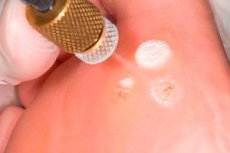Medical expert of the article
New publications
Removal of calluses with liquid nitrogen
Last reviewed: 04.07.2025

All iLive content is medically reviewed or fact checked to ensure as much factual accuracy as possible.
We have strict sourcing guidelines and only link to reputable media sites, academic research institutions and, whenever possible, medically peer reviewed studies. Note that the numbers in parentheses ([1], [2], etc.) are clickable links to these studies.
If you feel that any of our content is inaccurate, out-of-date, or otherwise questionable, please select it and press Ctrl + Enter.

One of the hardware methods of getting rid of calluses is their destruction using such a cryo-liquid as liquefied nitrogen, which in this aggregate state has a temperature of -195.8°C. It is this low temperature that allows cryoablation (cryodestruction) to be carried out – removal of calluses with liquid nitrogen. [ 1 ]
Indications for the procedure
Freezing, i.e. removal of the core callus with liquid nitrogen, can only be performed in cases where the use of salicylic acid patches, keratolytic ointments and creams (or folk remedies) does not produce the desired effect, and the focal area of plantar hyperkeratosis continues to interfere with walking, causing pain and discomfort.
Also read – Core callus: causes, structure, treatment.
In the same cases, dry calluses are also removed with liquid nitrogen. For more details, see – Dry calluses on the feet.
In addition, this method can be used to remove warts, nevi (moles), papillomas and even malignant skin neoplasms (for example, basal cell carcinoma), and also to use cryoablation with liquid nitrogen for keratoses - actinic and seborrheic.
Preparation
Preparation for the cryodestruction procedure of a callus consists of examining it and explaining to the patient the principle of action of liquefied nitrogen. Also, the specialist performing this procedure (dermatologist or podiatrist) gives instructions on what the patient should do at home so that the healing process after exposure to liquid nitrogen on the skin occurs without complications.
Technique blister removal with liquid nitrogen
When removing calluses, the cryoablation technique involves feeding liquid nitrogen to the problem area of the skin (for 15-20 seconds) through a catheter with the tip of a special device (cryodestrutor of various models) or applying cryofluid using a regular cotton applicator.
When liquid nitrogen comes into direct contact with the skin, the effect of low temperatures (from -30°C to -70°C) on the callus leads to local freezing of the pathologically thickened area and destruction (destruction or necrosis) of the tissue at the cellular level.
In domestic practice, local anesthesia is usually not performed, but only the site of action is disinfected.
Blisters turn white after liquid nitrogen, and the surrounding skin may become red, swollen, or painful for a few days; a blister (filled with serous fluid or blood) may appear, after which a crust (scab) forms after its disappearance (after 4-7 days). All this is considered a normal reaction to freezing the skin, which passes after a few days.
Contraindications to the procedure
Acute infectious diseases (with increased body temperature), diabetes mellitus (primarily the presence of diabetic foot), circulatory disorders in the lower extremities, mycosis of the feet, skin rashes in the form of urticaria, as well as pregnancy are contraindications to this procedure.
Care after the procedure
Care usually involves cleaning the area of any debris and changing dressings to prevent infection.
To speed up healing and prevent scab formation, it is recommended to apply a thin layer of petroleum jelly or ceramide cream to the treated area twice a day for one to one and a half weeks.
The scab that forms at the site of the blister should not be torn off: it will fall off on its own in one to two weeks.

